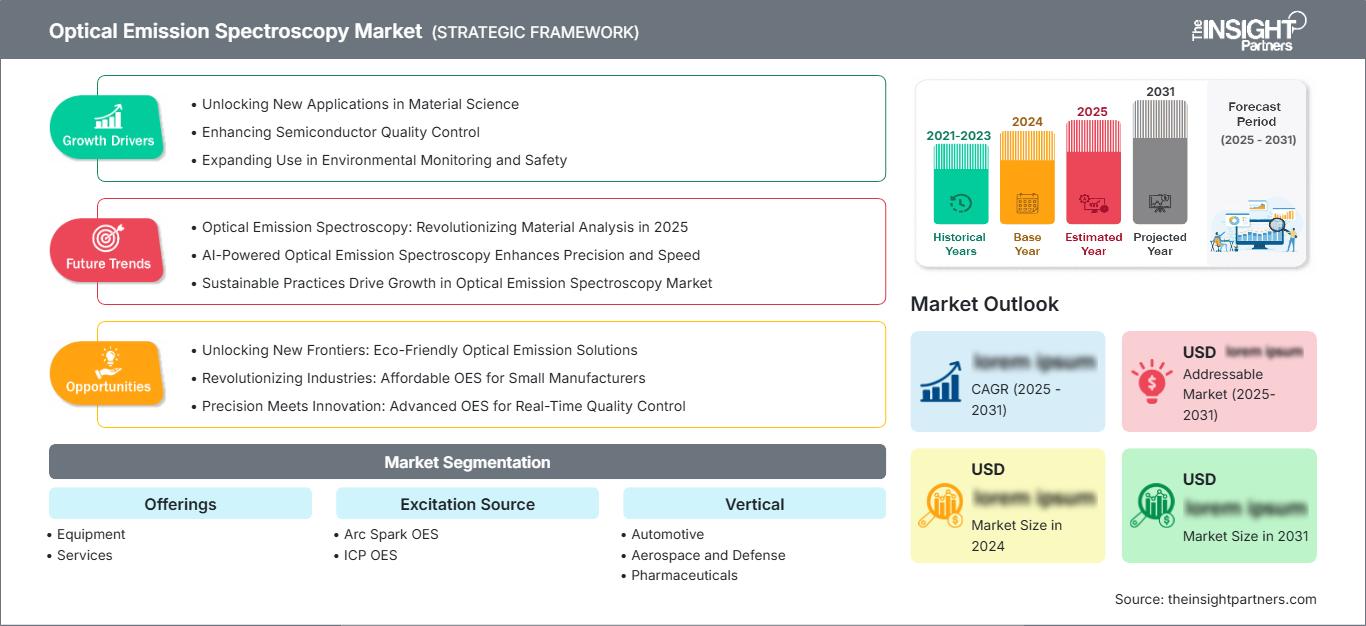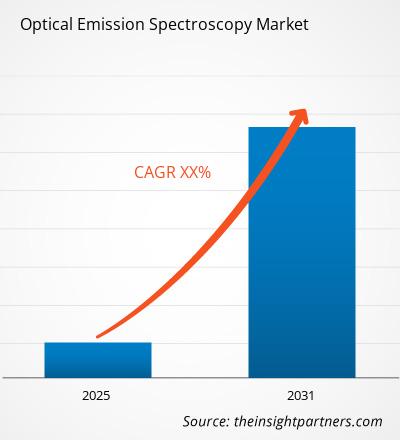Si prevede che il mercato della spettroscopia a emissione ottica registrerà un CAGR del XX% dal 2025 al 2031, con una dimensione del mercato in espansione da XX milioni di dollari nel 2024 a XX milioni di dollari entro il 2031.
Il rapporto è suddiviso in base alle offerte (apparecchiature, servizi) e analizza ulteriormente il mercato in base alla sorgente di eccitazione (Arc Spark OES, ICP OES). Esamina inoltre il mercato per settore verticale (automotive, aerospaziale e difesa, farmaceutico, alimentare e delle bevande, petrolio e gas). Per ciascuno di questi segmenti chiave viene fornita una ripartizione completa a livello globale, regionale e nazionale. Il rapporto include le dimensioni del mercato e le previsioni per tutti i segmenti, presentando i valori in dollari statunitensi. Fornisce inoltre statistiche chiave sullo stato attuale del mercato dei principali attori, insieme ad approfondimenti sulle tendenze prevalenti e sulle opportunità emergenti.
Scopo del rapporto
Il rapporto "Optical Emission Spectroscopy Market" di The Insight Partners mira a descrivere il panorama attuale e la crescita futura, i principali fattori trainanti, le sfide e le opportunità. Ciò fornirà spunti a vari stakeholder aziendali, come:
- Fornitori/Produttori di tecnologia: per comprendere le dinamiche di mercato in evoluzione e conoscere le potenziali opportunità di crescita, consentendo loro di prendere decisioni strategiche informate.
- Investitori: per condurre un'analisi completa delle tendenze in merito al tasso di crescita del mercato, alle proiezioni finanziarie di mercato e alle opportunità esistenti lungo la catena del valore.
- Enti di regolamentazione: per regolamentare le politiche e le attività di controllo sul mercato con l'obiettivo di ridurre al minimo gli abusi, preservare la fiducia degli investitori e sostenere l'integrità e la stabilità del mercato.
Offerte di segmentazione del mercato della spettroscopia di emissione ottica
- Attrezzature
- Servizi
Sorgente di eccitazione
- OES ad arco scintilla
- OES ICP
Verticale
- Automotive
- Aerospaziale e difesa
- Farmaceutica
- Alimenti e bevande
- Petrolio e gas
Potrai personalizzare gratuitamente qualsiasi rapporto, comprese parti di questo rapporto, o analisi a livello di paese, pacchetto dati Excel, oltre a usufruire di grandi offerte e sconti per start-up e università
Mercato della spettroscopia di emissione ottica: Approfondimenti strategici

-
Ottieni le principali tendenze chiave del mercato di questo rapporto.Questo campione GRATUITO includerà l'analisi dei dati, che vanno dalle tendenze di mercato alle stime e alle previsioni.
Fattori di crescita del mercato della spettroscopia a emissione ottica
- Sbloccare nuove applicazioni nella scienza dei materiali
- Migliorare il controllo di qualità dei semiconduttori
- Espandere l'uso nel monitoraggio ambientale e nella sicurezza
Tendenze future del mercato della spettroscopia a emissione ottica
- Spettroscopia a emissione ottica: rivoluzionare l'analisi dei materiali nel 2025
- La spettroscopia a emissione ottica basata sull'intelligenza artificiale migliora precisione e velocità
- Le pratiche sostenibili guidano la crescita del mercato della spettroscopia a emissione ottica
Opportunità di mercato della spettroscopia a emissione ottica
- Sbloccare nuove frontiere: soluzioni di emissione ottica ecocompatibili
- Rivoluzionare i settori: OES convenienti per i piccoli produttori
- La precisione incontra l'innovazione: OES avanzato per il controllo qualità in tempo reale
Approfondimenti regionali sul mercato della spettroscopia di emissione ottica
Le tendenze regionali e i fattori che influenzano il mercato della spettroscopia a emissione ottica durante il periodo di previsione sono stati ampiamente spiegati dagli analisti di The Insight Partners. Questa sezione illustra anche i segmenti e la geografia del mercato della spettroscopia a emissione ottica in Nord America, Europa, Asia-Pacifico, Medio Oriente e Africa, America meridionale e centrale.
Ambito del rapporto di mercato sulla spettroscopia di emissione ottica
| Attributo del rapporto | Dettagli |
|---|---|
| Dimensioni del mercato in 2024 | US$ XX Million |
| Dimensioni del mercato per 2031 | US$ XX Million |
| CAGR globale (2025 - 2031) | XX% |
| Dati storici | 2021-2023 |
| Periodo di previsione | 2025-2031 |
| Segmenti coperti |
By Offerte
|
| Regioni e paesi coperti |
Nord America
|
| Leader di mercato e profili aziendali chiave |
|
Densità degli attori del mercato della spettroscopia di emissione ottica: comprendere il suo impatto sulle dinamiche aziendali
Il mercato della spettroscopia a emissione ottica è in rapida crescita, trainato dalla crescente domanda degli utenti finali, dovuta a fattori quali l'evoluzione delle preferenze dei consumatori, i progressi tecnologici e una maggiore consapevolezza dei vantaggi del prodotto. Con l'aumento della domanda, le aziende stanno ampliando la propria offerta, innovando per soddisfare le esigenze dei consumatori e sfruttando le tendenze emergenti, alimentando ulteriormente la crescita del mercato.

- Ottieni il Mercato della spettroscopia di emissione ottica Panoramica dei principali attori chiave
Punti di forza
- Copertura completa: il rapporto analizza in modo esaustivo prodotti, servizi, tipologie e utenti finali del mercato della spettroscopia a emissione ottica, fornendo un panorama olistico.
- Analisi degli esperti: il rapporto è redatto sulla base della conoscenza approfondita di esperti e analisti del settore.
- Informazioni aggiornate: il rapporto garantisce la pertinenza aziendale grazie alla copertura di informazioni e tendenze dei dati recenti.
- Opzioni di personalizzazione: questo rapporto può essere personalizzato per soddisfare le esigenze specifiche del cliente e adattarsi in modo appropriato alle strategie aziendali.
Il rapporto di ricerca sul mercato della spettroscopia a emissione ottica può quindi contribuire a guidare il percorso di decodificazione e comprensione dello scenario del settore e delle prospettive di crescita. Sebbene possano esserci alcune valide preoccupazioni, i vantaggi complessivi di questo rapporto tendono a superare gli svantaggi.
- Analisi storica (2 anni), anno base, previsione (7 anni) con CAGR
- Analisi PEST e SWOT
- Valore/volume delle dimensioni del mercato - Globale, Regionale, Nazionale
- Industria e panorama competitivo
- Set di dati Excel
Report recenti
Testimonianze
Motivo dell'acquisto
- Processo decisionale informato
- Comprensione delle dinamiche di mercato
- Analisi competitiva
- Analisi dei clienti
- Previsioni di mercato
- Mitigazione del rischio
- Pianificazione strategica
- Giustificazione degli investimenti
- Identificazione dei mercati emergenti
- Miglioramento delle strategie di marketing
- Aumento dell'efficienza operativa
- Allineamento alle tendenze normative






















 Ottieni un campione gratuito per - Mercato della spettroscopia di emissione ottica
Ottieni un campione gratuito per - Mercato della spettroscopia di emissione ottica